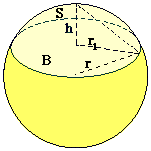WebCom 2015 Video
WebCom2015
Formules voor cirkel, bol, cilinder en nog wat...
- Cirkel, bol en cilinder
- Inhoud van een horizontale cilinder
- Inhoud en oppervlakte vergelijken
- Oppervlakte kegel
- Oppervlakte van de mantel van een afgeknotte kegel
- 'Wortelformule' voor derdegraads vergelijkingen?
- De abc-formule
- Bolkap
- Brekingswet van Snellius
- Omtrek en oppervlakte van een ellips
Cirkel, bol en cilinder
Cirkel:
Omtrek=2
r
Oppervlakte=r2
Bol:
Oppervlakte=4
r2
Inhoud=34r3
Cilinder:
Oppervlakte=2
rh+2
r2
Inhoud=r2h
Inhoud van een horizontale cilinder
We nemen een horizontaal geplaatste cilinder met een doorsnede vand cm en een lengte van a cm. Het vloeistofnivo staat op een hoogte van h cm. Hoeveel vloeistof zit er nu in de cilinder?
Voorbeeld
Neem d=2, a=6 en h=0,45 dan:
Met de Ti83 kan je dit benaderen met de functie fnInt:
12*fnInt(V(-x2+2x),x,0,0.45)=3.174552221Horizontale cilinder (2)
Een andere formule voor de inhoud van een horizontale tank is:
BRON:Finding the Volume of a Horizontal Tank
De R-index
"Is er een formule te bedenken voor de effectiviteit van verpakkingen?"
Zie Effectiviteit van verpakkingen.
Oppervlakte kegel
"Hoe bereken je oppervlakte van een kegel?"
Zie Afleiden van de formule voor de oppervlakte kegel.
Oppervlakte van de mantel van een afgeknotte kegel
"Hoe bereken je oppervlakte van de mantel van een afgeknotte kegel?"
'Wortelformule' voor derdegraads vergelijkingen
"Bestaat er niet een soort 'abc-formule' voor derdegraads vergelijkingen?"Zo eenvoudig als bij tweedegraads vergelijkingen zal het gaan. Hieronder staat de oplossing voor de vergelijking -x3+ax2+bx+c=0. Uiteraard kun je elke derdegraadsvergelijking omwerken tot deze vorm.
In de formule staat if(p<0){complex}. Dit betekent dat de oplossingen complex zijn.
De abc-formule
Voor een tweedegraads vergelijking van de vorm:
ax2 + bx + c = 0
kun de oplossingen uitrekenen met:
Zie abc-formule
Bolkap

Oppervlakte

Inhoud

De hoogte bij gegeven r en r1
Zie ook Volume bolkap
Brekingswet van Snellius
De invallende lichtstraal en de uittredende lichtstraal/gebroken straal liggen in hetzelfde vlak. De specifieke brekingsindex (die voor iedere combinatie van stoffen anders is) is constant:
sin i
sin r= constant = n Hierin:
i = hoek van inval
r = hoek van breking
n = brekingsindex (zie binas)Bij overgang van een optisch 'dichtere' naar optisch 'minder dichte' stof (vb. water -> lucht) vindt breking van de normaal af plaats. Lichtstralen zijn omkeerbaar dus van lucht naar water breekt licht naar de normaal toe. De grenshoek is de hoek van inval waarbij de hoek van breking 90 graden is. De grootte van de grenshoek volgt uit:
sin g = 1
nHierin:
g = grenshoek
n = brekingsindex
Omtrek en oppervlakte van een ellips
De oppervlakte van een ellips kan je berekenen met de formule:
Opp(ellips)=
·a·b
Hierin zijn a en b de 'stralen' van de ellips (zie tekening). Als a=b gaat de formule over in:
Opp(cirkel)=
·r2
De omtrek is een heel ander verhaal. Er bestaat geen eenvoudige formule om exact de omtrek van een ellips te berekenen. OpMathWorld@Ellipse kan je lezen dat de berekening van de omtrek te maken heeft met elliptische integralen van de tweede soort.
Op de website geven ze ook een manier om de omtrek te benaderen met een reeks:
Voor benaderingen van de omtrek kan je volgende formules gebruiken:
Omtrek
Omtrek
Omtrek
ESP8266 modules hardware guide
OK so there is this new(ish) chip the ESP8266EX that promises a full wifi stack and a mcu all for £2-3. But the chip on it’s own isn’t so useful – so most of the excitement has been around the various modules made with the chip, some memory and an antenna or connector for one. Unfortunately there is a lot of diversity, modules being revised and so on – which makes choosing one of these modules quite difficult. Here I’ve tried to bring together all the info I could about these different modules to help you choose which one fits your needs best. If you have any information about these modules then please leave a comment and I’ll incorporate it! The modules have attracted the codes ESP-01 through ESP-12 –this document in Chinese and this webshop catalog formed the starting point. The ESP8266.comcommunity and Squonk, shekel, TuxFanGKR and others deserve credit for gathering most of this infomation here.
 front of ESP modules ESP-01 through ESP-11
front of ESP modules ESP-01 through ESP-11 back of ESP modules ESP-01 through ESP-11
back of ESP modules ESP-01 through ESP-11
The basic attributes of these modules are as follows:
ESP-01 Variants:
Tinhead of the esp8266.com community contributed info about an older variant using the ESP8266 rather than ESP8266EX (may also be referred to as v080):
ESP-02 Variants:
TuxFanGKR of the esp8266.com community reported that a pinout variant had made him let the magic smoke out! And a third variant (confusingly named ESP-02 version 2) has been spotted here. Pinout is of TuxFanGKR’s variant – photo of ‘version 2′.
ESP-05 Variants:
A fifth pin has been added to the ESP-05 module carrying reset, thanks to esp8266.com contributors gbitand Didier9 for this info:
ESP-07 Variants:
A variant of the ESP-07 has been reported with 2 extra connections (one of them ADC) by mvdlande on the esp8266.com forum:
References:
ESP8266EX Pinout
Hardware guide
Any corrections, omissions or improvements? Please leave a comment!
Thanks to comment below, pinout of module ESP-11 has been corrected.















































